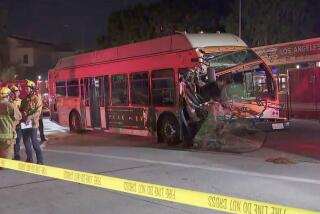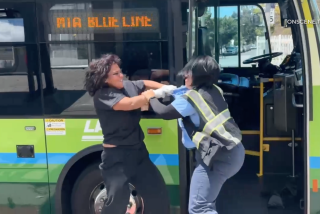Driver’s drowsiness blamed for Bronx bus crash that killed 15
- Share via
A bus crash in the Bronx that killed 15 passengers last year was caused by the driver’s drowsiness and the bus company’s inadequate oversight policies, the National Transportation Safety Board found.
The federal board said in a unanimous ruling released Tuesday that tour bus driver Ophadell Williams was at fault for the March 2011 predawn accident. Phone records and work schedules indicate that Williams could not have slept for more than three hours at a time in the 72 hours before the grisly crash — mostly during naps on the bus while passengers gambled in a Connecticut casino.
On the return trip to New York’s Chinatown, the bus was speeding at more than 30 mph over the limit when it struck a right-hand guardrail at 78 mph. The vehicle flipped onto its right side and skidded more than the length of a football field before ramming into a highway sign support pole.
The impact shoved the pole into the bus, shearing the roof off just above the windows like a can being opened. More than 30 people were injured.
“Fatigue and speed are an especially lethal combination,” NTSB Chairman Deborah A. P. Hersman said in a statement. “Unfortunately, in investigation after investigation, we are seeing the tragic results of fatigue, which can degrade every aspect of human performance.”
Representatives for the now-defunct company that operated the bus, World Wide Travel of Greater New York, could not be reached for comment.
The tragedy was “one of the deadliest crashes the NTSB has ever investigated,” Hersman said, and one of four major motor coach accidents on American highways in the last year. The others were a crash in New Hampshire with multiple injuries, a rollover in Doswell, Va., that killed four people and a tour bus crash on the New Jersey Turnpike that killed the driver and one passenger.
A list of recommendations for federal agencies could change safety standards across the country for motor coaches, as buses designed for long-distance travel are known. The recommendations include mandatory seat belts, on-board monitoring systems and more extensive background checks for potential drivers.
In the past, federal agencies have enacted more than 80% of the safety board’s recommendations, NTSB spokesman Peter Knudson said.
The motor coach industry transports as many passengers each year as the domestic airlines, he said.
Williams had been fired from two other companies and racked up 18 driving license suspensions over two decades before World Wide Travel hired him, investigators found. Williams has pleaded not guilty to charges of manslaughter and criminally negligent homicide.
The NTSB said Williams mostly worked overnight, driving to the casino in the late evening and returning in the early morning. On his days off, investigators said, he slept on a nocturnal sleep schedule, scrambling his body clock.
Williams told investigators he had slept during the day before the crash, but his cell phone and rental car had been used continuously, the report said.
The NTSB shut down World Wide Travel after the accident and said in the report that the company had “a corporate culture that fostered indifference to passenger safety.”
ALSO:
New York Gov. Cuomo seeks to cut marijuana penalty
Vatican: American nuns’ book on sex could harm Catholics
One final mission for WW II pilots: congressional recognition
More to Read
Sign up for Essential California
The most important California stories and recommendations in your inbox every morning.
You may occasionally receive promotional content from the Los Angeles Times.










